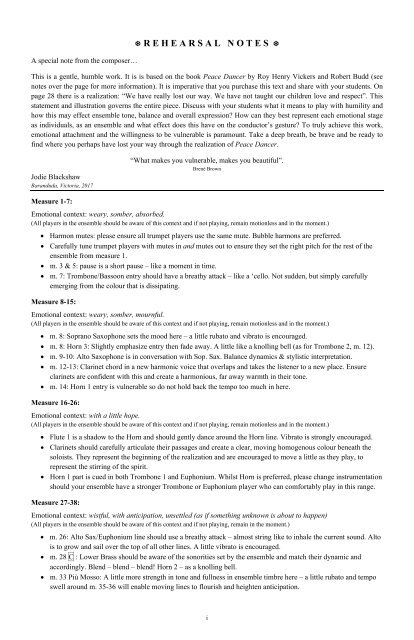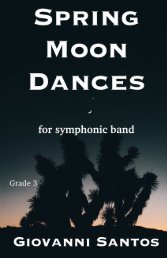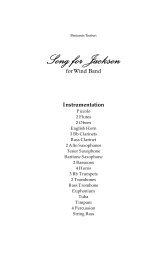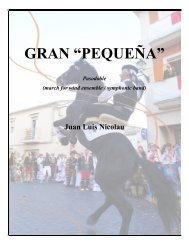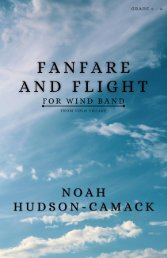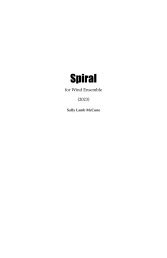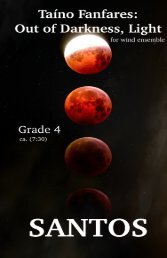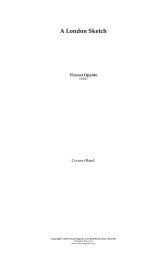Create successful ePaper yourself
Turn your PDF publications into a flip-book with our unique Google optimized e-Paper software.
A special note from the composer…<br />
T REHEARSAL NOTES T<br />
This is a gentle, humble work. It is is based on the book Peace Dancer by Roy Henry Vickers and Robert Budd (see<br />
notes over the page for more information). It is imperative that you purchase this text and share with your students. On<br />
page 28 there is a realization: “We have really lost our way. We have not taught our children love and respect”. This<br />
statement and illustration governs the entire piece. Discuss with your students what it means to play with humility and<br />
how this may effect ensemble tone, balance and overall expression? How can they best represent each emotional stage<br />
as individuals, as an ensemble and what effect does this have on the conductor’s gesture? To truly achieve this work,<br />
emotional attachment and the willingness to be vulnerable is paramount. Take a deep breath, be brave and be ready to<br />
find where you perhaps have lost your way through the realization of Peace Dancer.<br />
Jodie <strong>Blackshaw</strong><br />
Baranduda, Victoria, 2017<br />
“What makes you vulnerable, makes you beautiful”.<br />
Brené Brown<br />
Measure 1-7:<br />
Emotional context: weary, somber, absorbed.<br />
(All players in the ensemble should be aware of this context and if not playing, remain motionless and in the moment.)<br />
• Harmon mutes: please ensure all trumpet players use the same mute. Bubble harmons are preferred.<br />
• Carefully tune trumpet players with mutes in and mutes out to ensure they set the right pitch for the rest of the<br />
ensemble from measure 1.<br />
• m. 3 & 5: pause is a short pause – like a moment in time.<br />
• m. 7: Trombone/Bassoon entry should have a breathy attack – like a ‘cello. Not sudden, but simply carefully<br />
emerging from the colour that is dissipating.<br />
Measure 8-15:<br />
Emotional context: weary, somber, mournful.<br />
(All players in the ensemble should be aware of this context and if not playing, remain motionless and in the moment.)<br />
• m. 8: Soprano Saxophone sets the mood here – a little rubato and vibrato is encouraged.<br />
• m. 8: Horn 3: Slightly emphasize entry then fade away. A little like a knolling bell (as for Trombone 2, m. 12).<br />
• m. 9-10: Alto Saxophone is in conversation with Sop. Sax. Balance dynamics & stylistic interpretation.<br />
• m. 12-13: Clarinet chord in a <strong>new</strong> harmonic voice that overlaps and takes the listener to a <strong>new</strong> place. Ensure<br />
clarinets are confident with this and create a harmonious, far away warmth in their tone.<br />
• m. 14: Horn 1 entry is vulnerable so do not hold back the tempo too much in here.<br />
Measure 16-26:<br />
Emotional context: with a little hope.<br />
(All players in the ensemble should be aware of this context and if not playing, remain motionless and in the moment.)<br />
• Flute 1 is a shadow to the Horn and should gently dance around the Horn line. Vibrato is strongly encouraged.<br />
• Clarinets should carefully articulate their passages and create a clear, moving homogenous colour beneath the<br />
soloists. They represent the beginning of the realization and are encouraged to move a little as they play, to<br />
represent the stirring of the spirit.<br />
• Horn 1 part is cued in both Trombone 1 and Euphonium. Whilst Horn is preferred, please change instrumentation<br />
should your ensemble have a stronger Trombone or Euphonium player who can comfortably play in this range.<br />
Measure 27-38:<br />
Emotional context: wistful, with anticipation, unsettled (as if something unknown is about to happen)<br />
(All players in the ensemble should be aware of this context and if not playing, remain in the moment.)<br />
• m. 26: Alto Sax/Euphonium line should use a breathy attack – almost string like to inhale the current sound. Alto<br />
is to grow and sail over the top of all other lines. A little vibrato is encouraged.<br />
• m. 28 C : Lower Brass should be aware of the sonorities set by the ensemble and match their dynamic and<br />
accordingly. Blend – blend – blend! Horn 2 – as a knolling bell.<br />
• m. 33 Più Mosso: A little more strength in tone and fullness in ensemble timbre here – a little rubato and tempo<br />
swell around m. 35-36 will enable moving lines to flourish and heighten anticipation.<br />
i


